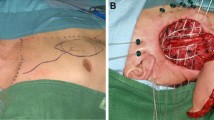Abstract
Purpose
Brachytherapy (BT) has been used for many years for disease control in tumours of the head and neck area (H&N). It is currently performed with high dose rate (HDR) or pulsed dose rate (PDR), but its use has been reduced due to the implementation of new non-invasive external beam radiotherapy techniques such as intensity modulation (IMRT) and volumetric modulated arc therapy (VMAT) and the improvement of surgical techniques.
Methods
The Spanish Brachytherapy Group (GEB) has carried out a survey to find out the number of centres in Spain that continue to use BT in H&N and its indications and expectations for the future.
Results
The results were presented at the XX GEB Consensus Meeting held on October 21, 2022, in Valencia (Spain) and it was confirmed that, although there are fewer and fewer centres that use BT in H&N, there are still units with extensive experience in this technique that should be positioned as referral centres.
Conclusion
It is necessary to carry out continuous work with other specialities involved, such as H&N surgeons, and other radiation oncologists, to improve the training of residents, both oncologists and medical physicists.

Similar content being viewed by others
References
Mazeron JJ, Ardiet JM, Haie-Meder C, Kovács G, Levendag P, Peiffert D, et al. GEC-ESTRO recommendations for brachytherapy for head and neck squamous cell carcinomas. Radiother Oncol. 2009;91:150–6.
Wierzbicka M, Bartochowska A, Strnad V, Strojan P, Mendenhall WM, Harrison LB, et al. The role of brachytherapy in the treatment of squamous cell carcinoma of the head and neck. Eur Arch Otorhinolaryngol. 2016;273(2):269–76.
Kovács G, Martinez-Monge R, Budrukkar A, Guinot JL, Johansson B, Strnad V, et al. GEC-ESTRO-ACROP recommendations for head and neck brachytherapy in squamous cell carcinomas: 1st update – Improvement by cross-sectional imaging-based treatment planning and stepping source technology. Radiother Oncol. 2017;122:248–54.
Santos MA, Guinot JL, Tortajada MI, Santamaría P, Campo V, Oliver L, et al. High-dose-rate interstitial brachytherapy boost in inoperable locally advanced tongue carcinoma. Brachytherapy. 2017;16(6):1213–8.
Bansal A, Ghoshal S, Oinam AS, Sharma SC, Dhanireddy B, Kapoor R. High-dose-rate interstitial brachytherapy in early stage oral tongue cancer - 15 year experience from a tertiary care institute. J Contemp Brachyther. 2016;8(1):56–65.
Takácsi-Nagy Z, Ferenczi Ö, Major T, Akiyama H, Fröhlich G, Oberna F, et al. Results of sole postoperative interstitial, high-dose-rate brachytherapy of T1–2 tongue tumours. Strahlenther Onkol. 2022;198(9):812–9.
Ianovski I, Mlynarek AM, Black MJ, Bahoric B, Sultanem K, Hier MP. The role of brachytherapy for margin control in oral tongue squamous cell carcinoma. J Otolaryngol Head Neck Surg. 2020;49(1):74.
Martínez-Fernández MI, Alcalde J, Cambeiro M, Peydró GV, Martínez-Monge R. Perioperative high dose rate brachytherapy (PHDRB) in previously irradiated head and neck cancer: results of a phase I/II reirradiation study. Radiother Oncol. 2017;122(2):255–9.
Bhalavat R, Pareek V, Chandra M, Nellore L, George K, Borade D, et al. High-dose-rate interstitial brachytherapy in recurrent head and neck cancer: an effective salvage option. J Contemp Brachyther. 2018;10:425–30.
Martínez-Monge R, Pagola Divassón M, Cambeiro M, Gaztañaga M, Moreno M, Arbea L, et al. Determinants of complications and outcome in high-risk squamous cell head-and-neck cancer treated with perioperative high-dose rate brachytherapy (PHDRB). Int J Radiat Oncol Biol Phys. 2011;81(4):e245–54.
Tagliaferri L, Bussu F, Fionda B, Catucci F, Rigante M, Gambacorta MA, et al. Perioperative HDR brachytherapy for reirradiation in head and neck recurrences: single-institution experience and systematic review. Tumori. 2017;103(6):516–24.
Santos M, Guinot JL, Tortajada M, Vendrell JB, López C, Rosa A, et al. Is perioperative brachytherapy effective in carcinoma of the tongue? J Contemp Brachyther. 2022;14(1):23–8.
Takácsi-Nagy Z, Martínez-Monge R, Mazeron JJ, Anker CJ, Harrison LB. American brachytherapy society task group report: combined external beam irradiation and interstitial brachytherapy for base of tongue tumors and other head and neck sites in the era of new technologies. Brachytherapy. 2017;16(1):44–58.
Akiyama H, Pesznyák C, Béla D, Ferenczi Ö, Major T, Polgár C, et al. Image guided high-dose-rate brachytherapy versus volumetric modulated arc therapy for head and neck cancer: a comparative analysis of dosimetry for target volume and organs at risk. Radiol Oncol. 2018;52(4):461–7.
Major T, Fröhlich G, Ágoston P, Polgár C, Takácsi-Nagy Z. The value of brachytherapy in the age of advanced external beam radiotherapy: a review of the literature in terms of dosimetry. Strahlenther Onkol. 2022;198(2):93–109.
Gaztañaga M, Pagola M, Cambeiro M, Rodriguez Ruiz ME, Aristu J, Montesdeoca N, et al. Comparison of limited-volume perioperative high-dose-rate brachytherapy and wide-field external irradiation in resected head and neck cancer. Head Neck. 2012;34(8):1081–8.
Tuček L, Vošmik M, Petera J. Is there still a place for brachytherapy in the modern treatment of early-stage oral cancer? Cancers (Basel). 2022;14(1):222.
Alva RC, Koushik ASK, Sweta B, Janaki MG, Ponni TRA, Kumar M, et al. Brachytherapy for oral cavity cancers in the era of intensity-modulated radiotherapy: save it or shelve it. Indian J Surg Oncol. 2020;11(3):406–11.
Author information
Authors and Affiliations
Corresponding author
Ethics declarations
Conflict of interest
All coauthors declare that there is no conflict of interest.
Ethical approval
All procedures performed in this study involving human participants were in accordance with the ethical standards of the 1964 Helsinki declaration.
Informed consent
Informed consent was obtained from all patients receiving brachytherapy in each hospital.
Additional information
Publisher's Note
Springer Nature remains neutral with regard to jurisdictional claims in published maps and institutional affiliations.
Rights and permissions
Springer Nature or its licensor (e.g. a society or other partner) holds exclusive rights to this article under a publishing agreement with the author(s) or other rightsholder(s); author self-archiving of the accepted manuscript version of this article is solely governed by the terms of such publishing agreement and applicable law.
About this article
Cite this article
Guinot, J.L., Diezhandino, P., de Frutos, J.M. et al. Status of head and neck brachytherapy in Spain in 2022. Clin Transl Oncol 26, 456–460 (2024). https://doi.org/10.1007/s12094-023-03265-8
Received:
Accepted:
Published:
Issue Date:
DOI: https://doi.org/10.1007/s12094-023-03265-8




